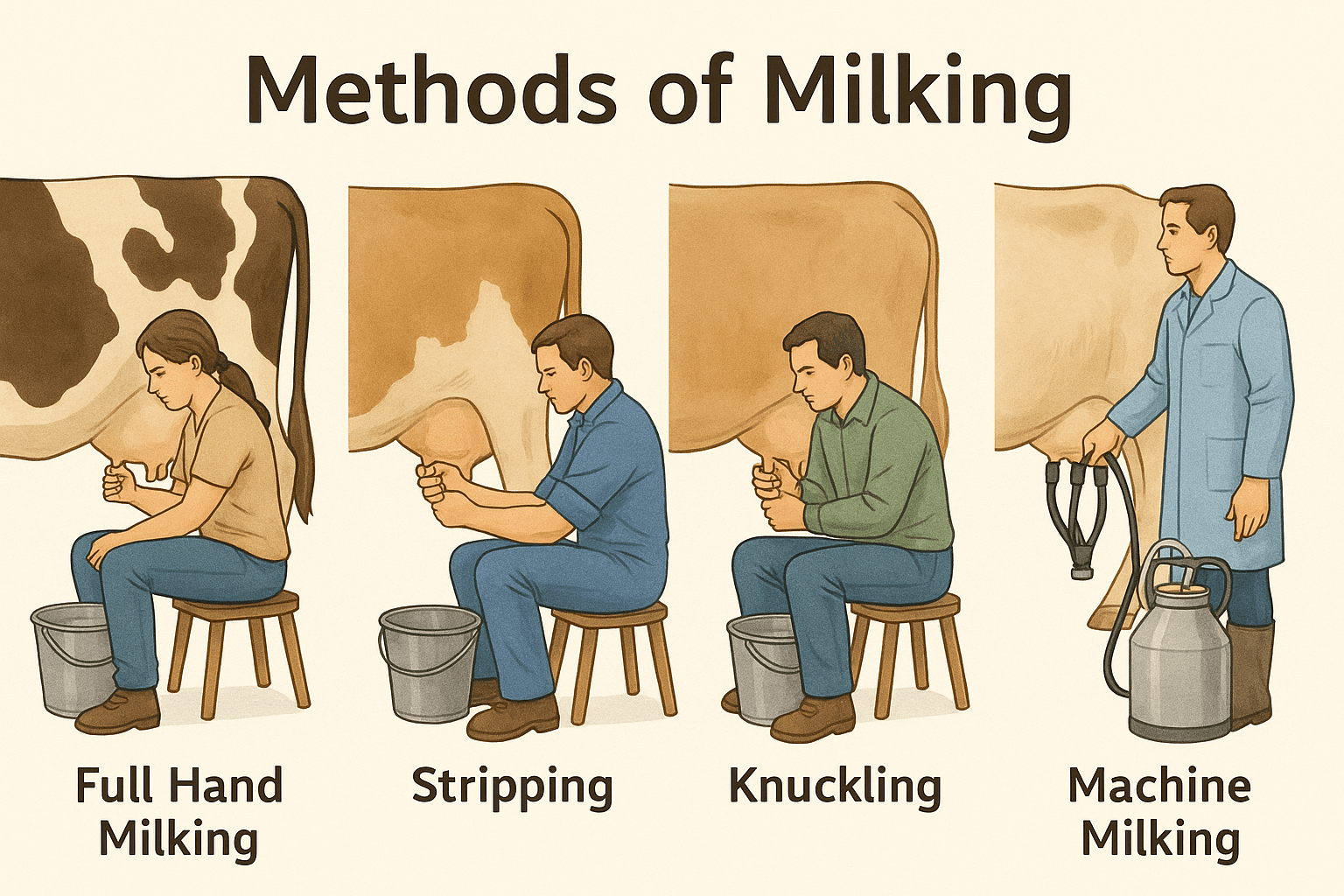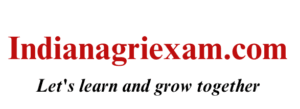
Methods of Milking; Milking is the process of extracting milk from the mammary gland (udder) of dairy animals. Efficient milking ensures good milk yield, udder health, and hygiene.
🔹 1. Hand Milking
a) Full Hand Milking (Recommended Method)
- The entire hand (fingers and thumb) is used to press the teat from top to bottom.
- Milk is squeezed out, not pulled.
- Prevents injury to teats and udder.
- Advantages:
- Hygienic
- Comfortable for animal
- Recommended for buffaloes and cows
b) Stripping
- Milk is pulled down by sliding fingers from top to bottom.
- Not recommended due to risk of teat injury.
- Used only to empty residual milk after normal milking.
c) Knuckling
- Teat is pressed using finger joints (knuckles).
- Harmful: May damage teat canal and lead to mastitis.
- Not advised.
2. Machine Milking
- Used in commercial dairy farms with large herd size.
- Works on vacuum and pulsation principle.
- Mimics suckling of calf by creating intermittent vacuum and release.
3. Wet vs. Dry Milking
|
Type |
Description |
|
Dry Milking |
Milking without applying water to teats. Most hygienic. Recommended. |
|
Wet Milking |
Teats washed immediately before milking without drying. Not recommended due to risk of contamination. |
🔹 Milking Principles
- Follow regular timing (interval of 12 hrs).
- Ensure clean hands and utensils.
- Start milking soon after let-down reflex (oxytocin release).
- Avoid stress to the animal.
- Strip the teats to check for mastitis.
Key Points for Exam
- Best method: Full-hand milking
- Machine milking: Based on vacuum principle
- Harmful method: Knuckling
- Let-down reflex: Stimulated by oxytocin
- Dry milking is more hygienic than wet milking
Thermal Processing of Milk
Purpose of Thermal Processing
- Most heat-resistant pathogen: Bacillus tuberculosis (Index organism).
- Key pathogens in milk: Tubercle bacilli, Typhus, Coliforms, Coxiella burnetii (Q-fever).
Types of Heat Treatments
|
Treatment |
Process |
Temperature (°C) |
Time (seconds) |
|
Pasteurization |
LTLT |
63 |
1800 Sec. (30 min) |
|
HTST (milk) |
72 |
15–20 |
|
|
HTST (cream) |
>80 |
15 |
|
|
Thermization |
– |
57–68 |
15 |
|
Sterilization |
– |
115–121 |
180–780 (20–30 min) |
|
Ultra-pasteurization |
– |
115–130 |
2–4 |
|
UHT |
– |
135–150 |
1–6 |
- Pasteurization
Definition: Heat treatment of milk to kill pathogens without affecting nutritional quality, followed by rapid cooling and refrigeration.
Types:
- LTLT (Low Temp Long Time):
- Temp: 63°C
- Time: 30 min
- Method: Batch process in jacketed vats (200–1000 L capacity)
- Suitable for: Small-scale operations
- HTST (High Temp Short Time):
- Temp: 72°C
- Time: 15 seconds
- Method: Continuous flow in plate heat exchangers
- Suitable for: Large-scale (≥5000 L/hr)
🔹 2. Thermization
- Purpose: Temporary heat treatment when immediate pasteurization isn’t possible.
- Temp: 63–65°C
- Time: 15 sec
- Benefit: Inhibits bacterial growth; spores revert to vegetative form for later destruction in pasteurization.
- Ultra-pasteurization
- Temp: 115–130°C
- Time: 2–4 sec
- Shelf life: Extended by 15–30 days
- Requires: Aseptic packaging, strict hygiene, cold storage (<4°C)
- Ultra High Temperature (UHT)
- Temp: 135–150°C
- Time: 1–6 sec
- Method: Direct (steam injection) or Indirect (heat exchangers)
- Aseptic packaging: Special multilayer containers
- Shelf life: 2–6 months without refrigeration
- Sterilization
- Temp: 115–121°C
- Time: 20–30 min
- Containers: Glass bottles or tin cans (200–400 g)
- Method: In-container (batch or continuous via autoclaves/hydrostatic towers)
- Result: Kills all microbes including spores.
- Microwave Heating
- Frequency: 915 or 2450 MHz
- Mechanism: Water dipole oscillation produces heat internally
- Benefits:
- Fast, uniform heating
- Reduced lag in heat penetration
- Challenges:
- Surface cooling due to evaporation
- Uneven absorption in frozen or high-salt foods
✅ Important Points to Remember
- Bacillus tuberculosis: Index organism for pasteurization.
- HTST is energy-efficient due to regeneration.
- Thermization is pre-treatment before pasteurization.
- UHT milk needs no refrigeration.
- Sterilization gives longest shelf life but may alter taste.
- Microwave heating is rapid but less uniform.

